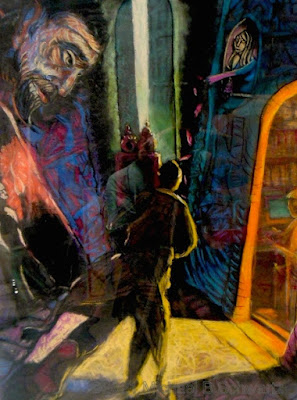misTaken Identities
an online exhibition of paintings and drawings
inspired by stories of Jewish invisibility in the Southwest
The southwestern United States has a mesmerizing ambiance. A tapestry of cultures that includes a special story, that of the hidden Jewish peoples of the Southwest. Cloaked in mystery and intrigue the stories, songs and legends that permeate dinner tables and camp fires, names of streets and organizations all have clues to this history. As I listened carefully I realized clues were being dropped, bread crumbs for me to quietly follow.
“My people got lost on their long journey from León” one friend told me with a wink. A student quietly wishes me “Shanoa Tova Mr.” and rushes off with a smile. “The way my grandmother wove dough for bread on Fridays was different, she braided it” a Barrio elder once told me. “You are my people?” I asked. “Yes”, he responded gently.
These fascinating clues, puzzle pieces, were starting to take form. I began visually researching the forced expulsion of Jewish and Muslim peoples from Spain in 1492. I was blessed to befriend Arizona Daily Star sports writer Abe Chanin (1921-2014) who founded the Southwest Jewish Archives at the University of Arizona. Abe guided my initial learning on this subject. He operated an anonymous hotline that people could call in and share their stories. The response was mind boggling. His challenge to me was to tell this story through the arts.
The Jewish “Sepharad” came to be known as "Conversos" or "Moranos". The Sephardic diaspora spread people throughout the Ottoman Empire, North Africa, and the Americas. Here in the US Jews wandered north from places such as the recently colonized “New Kingdom of León” (Mexico) to escape deadly inquisitional courts. Today evidence of this Anusim is evidenced throughout the Southwest. In bakeries, gatherings, on signs, landmarks, graveyards and street names.
Prior to the development of the sextant, astrolabes were instruments, produced by craftspeople, used to make astronomical measurements, typically of the altitudes of celestial bodies, and in navigation for calculating latitude. There were Jewish craftspeople who created astrolabes, which were inscribed in Hebrew.
This work in this exhibit revolves around the general theme of the Hidden Jewish Communities, specifically the Sephardic and references to the Mashhadi experiences. Enjoy, and I look forward to your feedback.
- Michael B Schwartz
 |
| 4. "Shhhhh" Ink on Paper 5” x 14” |
"The Mashhadi Jewish peoples, The Hidden Jewish of Iran, were forced to pretend to convert to Islam from 1839 to 1925. For 200 years they hid their identity."
 | |
| 8. "Torah Hug" Pastel on paper 18” x 24” |
 | |
| 10. "journey" Acrylic on Canvas Board 12” x 16” |
"Do you remember, do you forget, did we remember to close the door? wandering, sailing - through these centuries we are."
 |
| 12. "relocating" Mixed Media on Paper 24” x 36” |
"Had we been without our stories and navigational equipment all would have been lost, somehow we had to find a ship to stow away on, to reunite with our community, oh if only we could find a way home."
 |
| 17. "Sevilla, Spain 1371" Acrylic on Wood 24” x 36” |
"We should have known, in 1369 physician and astrologer Abraham ibn Zarzal was called into doubt for no reason at all, what was it with these accusations!"
 |
| 20. "An Astrolabe" Acrylic on Canvas 30” x 48” |
“People frequently associate astrolabes with navigation. Although the
instrument used in navigation was a simplified version of the more
complex planispheric astrolabe and its use did not start until the 15th
century, I would like to keep this image of seas and new lands
associated to our research; for the astrolabe is bringing us a new
insight into many aspects of the life and interests of medieval Jews,
and some discoveries.”
Dr. Josefina Rodriguez Arribas
 |
| 23."The Order" Ink, Acrylic on Paper 24” x 36” |
“1492, the order came, banishment, death, conversion or some such
combination. we gathered what we could, we knew this day was coming, it
was in the air.”
 |
| 24. “Run” Pastel on Paper 24” x 36” |
"We did not want to give up our wonderful lives in Spain, a place for generations we had called home. But it was this, forced conversion or death. How many perished in those days we still do not know. BDE”
Additional Reading:
Society for Crypto-Judaic Studies
Beit Hatfutsot - Museum of the Jewish People
Southwest Jewish Archives
































